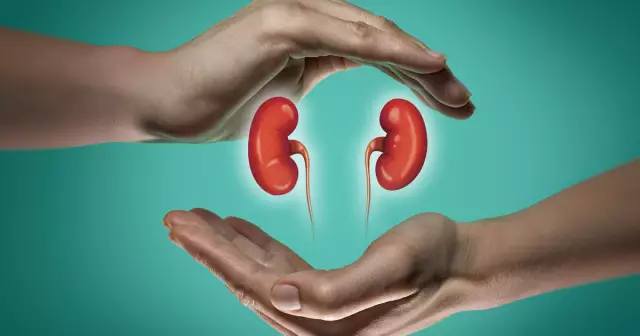- Author Rachel Wainwright [email protected].
- Public 2023-12-15 07:39.
- Last modified 2025-11-02 20:14.
erectile disfunction
The content of the article:
- Forms
- Erectile dysfunction causes and risk factors
- Symptoms
- Diagnosis of erectile dysfunction
- Erectile Dysfunction Treatment
- Prevention
- Complications
- Forecast
Erectile dysfunction, or impotence (from Latin impotens - powerless) is an integral part of the problem of sexual dysfunctions, a persistent inability to achieve and maintain an erection at the level necessary to ensure a full sexual intercourse.

Erection (from Lat. Erectio - to straighten) is a neurovascular process that is directly related to the amount of blood pressure inside the cavernous (cavernous) bodies of the penis. During sexual stimulation, biologically active substances (mainly nitric oxide) are released from the nerve endings, which relax the smooth muscles of the cavernous bodies of the penis, as well as the muscles of the arteries. This leads to vasodilation, increased blood flow in the penis, dilation and filling of the cavernous spaces with blood. At the same time, the veins that perforate the tunica albuginea of the cavernous bodies of the penis narrow, and passive venous outflow is impeded.
Filling of the cavernous bodies of the penis with blood and veno-occlusion lead to an erection. During intercourse, this state of the vessels remains, the inflow and outflow of blood stops, and intracavernous pressure increases. There is an increase in the volume of the penis and a further increase in erection.
Erectile problems over a prolonged period (3-6 months) are grounds for suggesting erectile dysfunction.
According to the WHO, about 160 million men worldwide suffer from erectile dysfunction. Every tenth man over 21 suffers from an erectile dysfunction, about 50% of men over 40 experience various difficulties associated with erectile dysfunction, every third man over 60 is not able to perform sexual intercourse.
Forms
According to the etiological factor, the following types of erectile dysfunction are distinguished:
- psychogenic;
- organic;
- mixed.
Among psychogenic erectile dysfunctions, there are also primary and secondary forms:
- the primary (congenital) form is rare and is characterized by the complete absence of normal sexual function throughout life;
- secondary erectile dysfunction is characterized by the gradual extinction of the previously existing ability to erect.
Erectile dysfunction causes and risk factors
The causes of erectile dysfunction are subdivided according to the pathophysiological mechanisms underlying its occurrence.
Organic causes are associated with malfunctioning of internal organs or systems. These include:
- vascular. Insufficient blood pressure in the vessels of the arterial bed leads to an inadequate supply of blood to the cavernous bodies, and contraction of smooth muscles opens the way for passive venous outflow. Weakening or absence of erections can be a manifestation of arterial hypertension, obliterating endarteritis, hyperlipidemia, atherosclerosis, arterial damage caused by radiation to the pelvic region, as well as heart failure, coronary heart disease and myocardial infarction;
- neurological. Diseases of the parasympathetic pelvic visceral nerves and pathology of the nerve pathways can lead to impaired redistribution of blood flow, insufficient pressure in the corpus cavernosum, impaired ability to erections. Potency is affected by neurological disorders in Alzheimer's disease, Parkinson's disease, polyneuropathy, multiple sclerosis, hemorrhagic or ischemic stroke, injuries of the spinal cord, small pelvis and perineum, degeneration of intervertebral discs, craniocerebral trauma, cerebral insufficiency, etc.;
- endocrine. The causes of impotence of endocrine genesis include increased levels of prolactin, endogenous estrogens and a decrease in the level of androgens, diseases associated with dysfunction of the pituitary and adrenal glands;
- iatrogenic. They are explained by the side effects of a number of drugs (neuroleptics, tranquilizers, antihypertensive drugs, anticonvulsants, cytostatics, antidepressants, 1st generation antihistamines, corticosteroids, etc.) on sexual function;
- toxic. Caused by the toxic effects of alcohol, drugs, nicotine.
Psychogenic causes are associated with central suppression of the erection mechanism. These include increased anxiety, lack of sexual arousal, neuroses, mental illness (depression, schizophrenia). It has been proven that the psychological causes of erectile dysfunction are based on organic diseases. In most patients with erectile dysfunction, a combination of psychogenic and organic components is found.
Aging is an independent risk factor for erectile dysfunction. The leading causes of erectile dysfunction with aging are age-dependent decrease in testosterone levels, vascular pathologies and chronic infectious diseases of the urogenital sphere. Sexual disorders progressively increase with aging: in the 50-60 age group, the number of patients is 10%, and after 80 years - already 80%.
Symptoms
Symptoms of erectile dysfunction include:
- insufficient quality morning erections or their absence;
- the inability to enter the penis due to insufficient tension;
- premature ejaculation;
- an increase in the time interval between sexual stimulation and erection;
- defective erections or complete absence of an erection upon stimulation;
- inability to introject and maintain an erection until ejaculation;
- decrease in ejaculate volume;
- an increase in the recovery period between erections.
Psychogenic and organic erectile dysfunctions have their own characteristics.
Psychogenic erectile dysfunction begins suddenly. Characterized by the presence of problems in relationships, the presence of nocturnal spontaneous erections. As a rule, erection problems are episodic. After eliminating the external problem, normal erection is usually restored.
Erectile dysfunction of organic genesis is accompanied by systematic erectile dysfunction. This form of the disease begins gradually and is rarely accompanied by spontaneous nocturnal erections.
Diagnosis of erectile dysfunction
Diagnosis of erectile dysfunction begins with the collection of a general history, identifying etiological factors, and an assessment of sexual activity. A number of questionnaires have been developed to identify the pathophysiological basis of impotence.
Physical examination often reveals signs of vascular, neurological or hormonal disorders, confirming the pathophysiological hypothesis based on the history data: the presence of signs of hypogonadism, fibrotic changes, gynecomastia, phimosis, detection of La Peyronie's plaques, disturbances in perineal sensitivity, decreased tone of the anal sphincter of the lower extremities, atrophy, changes in peripheral pulsations.
Diagnostics should include screening of major vascular, metabolic and endocrine diseases, determination of testosterone levels.

Source: umedp.ru
For an objective assessment of the state of the physiological mechanisms that control the erection process, a number of techniques are used:
- assessment of the state of the vascular system - determination of the level of blood flow in the pelvic arteries using vascular Doppler ultrasonography of the arteries of the penis, plethysmography and radioisotope studies;
- assessment of neurological status - determination of the threshold of sensitivity of the penis to vibration using a biothesiometer (helps to detect early manifestations of peripheral sensory neuropathy), electromyography of the muscles of the perineum, study of the refractoriness of the sacral nerves, registration of brain potentials in case of irritation of the external genital organs (helps to determine erectile dysfunction of neurogenic origin) … If, during the screening tests, the patient has a neurological pathology, electroencephalography, computed tomography of the brain or myelography are performed;
- assessment of the endocrine system - measuring the concentration of testosterone, prolactin, luteinizing hormone in the blood plasma;
- assessment of the patient's mental state - identification of a psychological, causal relationship (situational impotence), mental disorders (anxiety, depression, shame, guilt).
For the differential diagnosis of forms of erectile dysfunction, a procedure for evaluating nocturnal erections (NEE) using a plethysmographic sensor is used. The differentiation is based on the fact that patients with psychogenic erectile dysfunction develop normal erections during sleep, while patients with organic erectile dysfunction have inferior nocturnal erections.
Erectile Dysfunction Treatment
The goal of treatment is to achieve satisfactory erections with minimal side effects.
In the treatment of the psychogenic form of erectile dysfunction, psychotherapy plays an important role. It should be aimed at eliminating the causes that led to sexual maladjustment, resolving intrapersonal and interpersonal problems, and forming adequate ideas about intimate relationships. The techniques of matrimonial therapy, training partners in effective interaction, methods of cognitive-behavioral therapy are used.
When treating the organic form, it is of paramount importance to eliminate the disease that led to erectile dysfunction. If impotence has endocrine causes, hormone replacement therapy is prescribed.
Pharmacological agents are widely used to enhance and prolong erection. The first-line drugs are oral PDE-5 inhibitors. PDE 5 is an enzyme found in the cavernous tissue. Blocking its work leads to relaxation of the smooth muscles of the corpora cavernosa and the emergence of an erection in response to sexual stimulation.
It is also possible to inject drugs directly into the corpus cavernosum. In this case, a very thin needle is used, with the help of which the patient can independently inject the vasodilator selected by the doctor. A unilateral injection is sufficient for bilateral enlargement of the penis due to cross blood flow. After 15 minutes, an erection occurs, which lasts up to two hours. The method has disadvantages - inconvenience of use and rare side effects, such as priapism and fibrosis of the penis (2%).
Another method that increases blood flow to the penis is vacuum constrictor therapy. In this case, the use of a vacuum device enhances blood flow into the corpora cavernosa of the penis, and the constrictive ring prevents venous outflow.

Source: citymed74.ru
Massage and self-massage of the pelvic and pubic bone area is effective, since it has a beneficial effect on the vascular tone in the genital area.
Regular exercise is also recommended, erectile dysfunction is characterized by a sedentary lifestyle and chronic stagnation of blood in the pelvic region, exercises are prescribed to stimulate and strengthen the muscles surrounding the penis and scrotum. Squats are considered the most effective exercise for strengthening erection; it is recommended to perform 50-100 squats a day. This helps to normalize blood circulation in the pelvic area. An equally effective method is tension and relaxation of the muscles of the perineum. Such an exercise is convenient in that it can be performed in any position an arbitrary number of times. Walking also gives positive results in the fight against insufficient erection.
If non-invasive methods are ineffective, surgery is indicated:
- endophaloprosthetics - the installation of prostheses in the cavernous bodies of the penis; carried out with damage to the cavernous tissue;
- microsurgical revascularization of the penis - creating an anastomosis between the dorsal artery of the penis and the iliac vessels; is carried out for vascular forms of erectile dysfunction;
- methods of venous surgery - spongiolysis, endovascular resection, embolization or ligation of veins, ligation of the legs of the penis; used for lesions of the veno-occlusive mechanism.
Prevention
General measures for the prevention of erectile dysfunction include:
- rational organization of the daily routine, optimal alternation of work and rest, a good night's sleep;
- a balanced diet, a diet enriched with vitamins and microelements, essential amino acids and polyunsaturated fatty acids;
- regular sexual activity without prolonged abstinence and excesses;
- quitting smoking, alcohol abuse, taking any drugs;
- regular physical activity, sports, including in the fresh air;
- weight loss with increased body weight;
- absence of prolonged stressful situations at work and at home;
- limiting the intake of drugs that can disrupt erection;
- prevention and treatment of chronic diseases leading to erectile dysfunction.
Complications
The consequence of erectile dysfunction is an unsatisfactory sex life, which leads to further disorders:
- stress, anxiety, neurasthenia, depression;
- lowered self-esteem;
- problems in the relationship with a sexual partner;
- infertility.
Forecast
The prognosis of treatment depends on the cause of the erectile dysfunction and the patient's age, but is generally favorable.
YouTube video related to the article:

Anna Kozlova Medical journalist About the author
Education: Rostov State Medical University, specialty "General Medicine".
The information is generalized and provided for informational purposes only. At the first sign of illness, see your doctor. Self-medication is hazardous to health!






